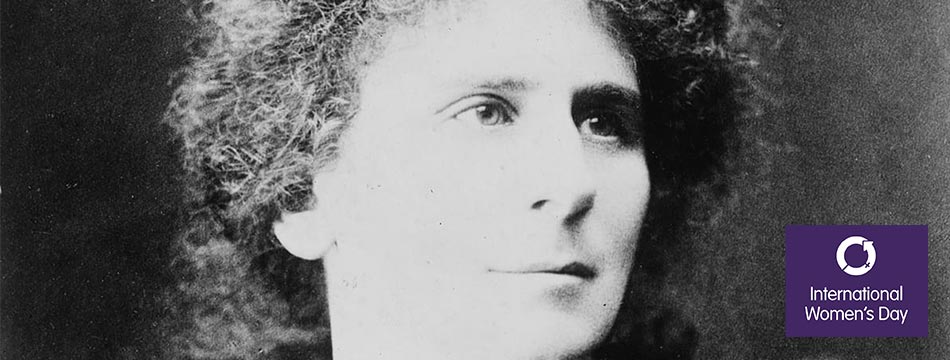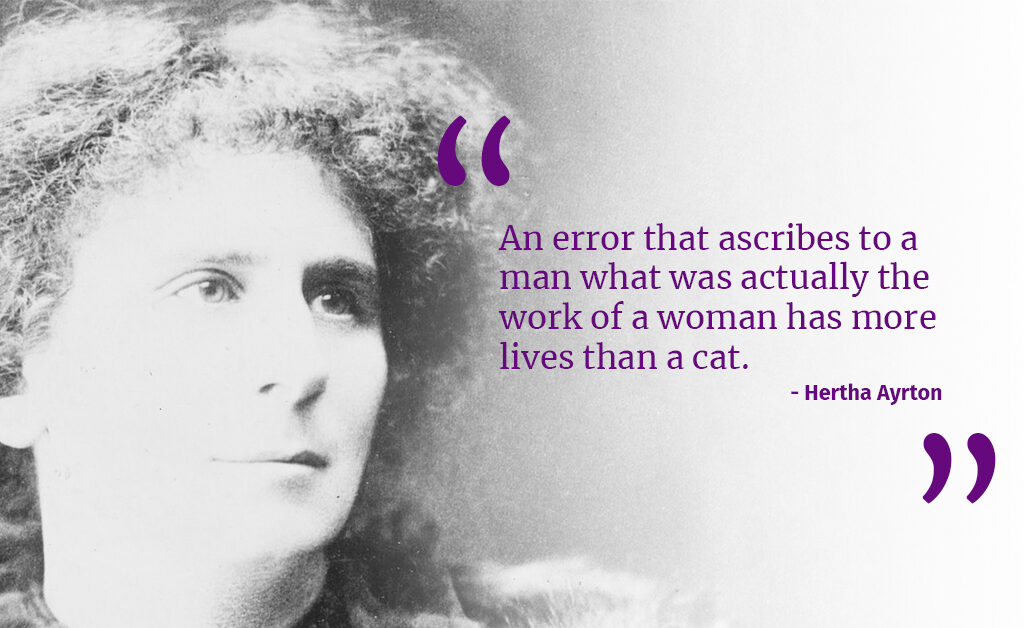
For International Women’s Day (8th Match 2021), we thought we would tell you about Hertha Ayrton, a pioneer in the field of electrical engineering and the first woman to be elected as a member of the Institute of Electrical Engineers, known these days as the IET (The Institute of Engineering and Technology). The IET is a multidisciplinary professional engineering institution, advisory body, and publisher of electrical regulations.
Quick Links
Hertha Ayrton[1]
Born Phoebe Sarah Marks in Portsea, Hampshire on the 28th April 1854, Hertha Ayrton grew up to become a suffragette, physicist, mathematician, inventor, and one of the first women to work in electrical engineering in the UK. She was agnostic and changed her name in her teens, choosing Hertha from Algernon Charles Swinburne’s poem of the same name which is critical of organised religion.
Ayrton was educated by her aunts in London before studying mathematics at Girton College, Cambridge. Despite passing the Mathematical Tripos exam in 1880, she was not awarded an academic degree by the university as it was their policy to award only certificates to female graduates. However, she passed an external exam at the University of London in 1881, allowing her to attain a full Bachelor of Science degree.
Following graduation, Ayrton taught and embroidered to support herself while running a working girls club and caring for her sister. In this time, she also invented and patented (with the support of philanthropist and activist Louisa Goldsmith, and feminist Barbara Bodichon) a line-divider. This patent, registered in 1884, was the first of twenty-six patents Ayrton would file in her lifetime: five on mathematical dividers, thirteen on arc lamps and electrodes, and eight on the propulsion of air. In 1884 Ayrton also began taking classes on electricity at Finsbury Technical College. The lessons were delivered by Professor William Edward Ayrton, the man who would eventually become her husband in 1885 and father to her daughter, Barbara Bodichon Ayrton, in 1886.
Hertha Ayrton helped her husband, who was a fellow of the Royal Society, with his physics and electricity experiments while carrying out her own investigations into electric arc. She published several articles in The Electrician detailing that flicker and hiss, common problems associated with public/electric arc lighting, could be attributed to oxygen interacting with carbon rods. Her discoveries in this area led her to become the first woman to read a paper before the Institute of Electrical Engineers, known today as the IET. She read her paper titled ‘The Hissing of the Electric Arc’ in 1899 and shortly afterwards became the first female member of the IEE.
Around the turn of the century, Hertha Ayrton’s work was beginning to be recognised more and more widely both within Britain and around the world. Ayrton led the physical science section at the International Congress of Women, held in London in 1899, and she spoke at the International Electrical Congress hosted in Paris in 1900. Ayrton’s successful speech at the Paris conference inspired the British Association for the Advancement of Science to start permitting women onto general and sectional committees.
Despite her achievements, the Royal Society wasn’t as welcoming. They were not initially supportive of her work and blocked her request to present ‘The Mechanism of Electric Arc’ in 1901. Instead, her paper was read by John Perry, an Irish engineer and mathematician. ‘The Mechanism of Electric Arc’ was the first of seven of Aryton’s papers to be read before the Royal Society; the last was delivered posthumously in 1926.
In 1902, John Perry’s proposal that Hertha Ayrton should be made a fellow of the Royal Society was also blocked because as a married woman she was not considered a ‘person’ in the eyes of the law.[2] This was despite the success of The Electric Arc, a summary of her research and work into electric arcs, which had cemented her reputation as a significant figure in the field of electrical engineering.
However, the academy’s resistance to Hertha Ayrton began to thaw slightly in 1904, when she became the first woman to read her own paper before the Royal Society. Her paper titled ‘The Origin and Growth of Ripple Marks’ was later published in the Proceedings of the Royal Society. Furthermore, in 1906 the Royal Society awarded Ayrton the Hughes Medal ‘for her experimental investigations on the electric arc, and also sand ripples.’ To date, Hertha Ayrton is one of only three women to be honoured with this award. The others are Michele Dougherty in 2008 and Clare Grey in 2020.

In addition to her incredible work and contributions to science, physics, and particularly electrical engineering, Ayrton campaigned as a suffragette. She attended marches, was part of Emily Pankhurst’s delegation to petition the Prime Minister on the 18th November 1910 (although they ended up meeting his private secretary instead), and nursed recently released women who had undergone force-feeding back to health. As a close friend of Marie Curie, she fervently opposed the notion that Curie’s discoveries were actually the work of her husband; an issue of misappropriation that she was familiar with herself. Ayton wrote, “errors are notoriously hard to kill, but an error that ascribes to a man what was actually the work of a woman has more lives than a cat.”[3]
Hertha Aryton was a staunch supporter of the Women’s Engineering Society, a charity and professional network still in existence today. She also helped to found the International Federation of University Women in 1919, and the National Union of Scientific Workers in 1920.
On the 26th August 1923, Hertha Ayrton died from blood poisoning. She was 69 years old.
Women in Engineering Today
The theme of this year’s International Women’s Day is #ChooseToChallenge.[4] Hertha Ayrton was certainly a woman who chose to challenge the limitations, gender biases, and inequality she experienced as a woman.
In recent years, there has been a consistent effort to challenge stereotypes and barriers associated with engineering with a view to increasing the number of women working in the sector and thereby reducing the gender imbalance. In a Gender Disparity in Engineering report carried out by Engineering UK in 2018, it was discovered that only 21% of employees in the engineering sector are women, and only 12% of all engineers are female.[5]
IET Campaigns & Awards
To address the gender disparity in engineering and STEM, the IET, an organisation that supported Hertha Ayrton, has implemented several awards and campaigns designed to increase the number of girls and women working in these sectors. These drives focus on breaking down stereotypes and making engineering and STEM careers more appealing to girls and women.[6]
9% Is Not Enough
In 2016 it was estimated that only 9% of the UK’s engineering and technology workforce was female. To highlight this issue IET instigated the #9percentisnotenough social media campaign. It won four industry awards. The success meant that IET were able to run an accompanying conference and workshop of the same name, where engineering and HR managers could debate practical solutions to recruiting and retaining more women in STEM.
Portrait of an Engineer
To dispel the myth that all engineers are hard hat- and dirty overall-wearing, middle-aged men, in 2017 IET launched the #PortraitOfAnEngineer campaign. They partnered with Rankin Studios, famed photographers to the stars, to capture photos of previous YWE winners, finalists, and affiliates in order to showcase the diversity amongst engineers.
Smash Stereotypes to Bits
Upon hearing that only 12% of young people felt their current studies made them want to pursue a career in STEM, IET created a video and social media campaign that illustrated the skills women and girls could learn studying engineering.
Young Woman Engineer of the Year (YWE) Award
IET sponsors a number of awards acknowledging the talent of early-career female engineers. The Young Woman Engineer of the Year (YWE) Award was initiated in 1978 under the name Girl Technician of the Year. It was renamed Young Woman Engineer of the Year in 1988.
Ella Podmore, a Materials Engineer for McLaren Automotive, was 2020’s winner.
Like Hertha Ayrton, IET is choosing to challenge, and, hopefully, we will soon see that 12% of female engineers rise. This International Woman’s Day we also encourage you to #ChooseToChallenge.
[1] The information about Hertha Ayrton was mainly gathered using the following sources:
- Magnificent Women, 74: Hertha Ayrton, last accessed 08 March 2021
- Wikipedia, Hertha Ayrton, last accessed 08 March 2021
Where additional sources have been used, references have been added.
[2] The Royal Society, Almost a Fellow: Hertha Ayron and an embarrassing episode in the history of the Royal Society, last accessed 08 March 2021 <https://royalsociety.org/blog/2012/03/almost-a-fellow/
[3] Pam Hirsch, ‘Hertha Ayrton’, in The Encyclopaedia of Jewish Women, last accessed 08 March 2021 <https://jwa.org/encyclopedia/article/ayrton-hertha-marks>
[4] International Women’s Day, IWD 2021 campaign theme: #ChooseToChallenge, last accessed 08 March 2021 <https://www.internationalwomensday.com/theme>
[5] Engineering UK, Gender disparity in engineering, (2018), p3-4
[6] The information about IET's campaigns was taken from IET, Gender Diversity, last accessed 08 March 2021 <https://www.theiet.org/media/campaigns/gender-diversity/>


